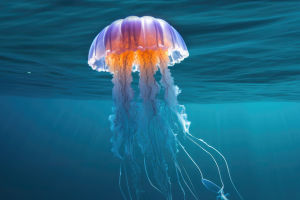Whales are fascinating creatures of the subphylum Vertebrata, Mammalia. They are divided into two categories, baleen whales and toothed whales.
There are nearly 100 species of whales, all of which live in the ocean, but some live in freshwater, although the number of species that live in freshwater is relatively small. In our waters, there are about 30 species of whales.
These different species of whales are quite different in appearance and size. Sadly, the oceans where whales live are often polluted, and human hunting and killing activities have led to a gradual decrease in the number of whales. As a result, some species of whales are now very few.
The toothed whale suborder includes the sperm whale family, minke whale family, rhesus whale family, beaked whale family, subfamily, family Laetidae, dolphin family, porpoise family, and narwhal family.
Baleen whales, such as humpback whales and blue whales, are the class of whales that we traditionally call "whales" and are toothless. On the other hand, toothed whales, such as dolphins, are toothed.
Cetaceans, the most adapted of modern mammals to live in water, evolved a near-fish-like appearance during the transition from terrestrial to aquatic, while body hair degraded, as did sweat and sebaceous glands as cetaceans eventually became fully aquatic.
Cetaceans have a keen sonar system that can use echolocation functions to send out acoustic signals for feeding and communication. The sonar invented by humans was invented through the sonar principle of whales and dolphins.
Cetaceans rely on their acute sense of hearing to survive underwater, but baleen whales and toothed whales show great differences in their hearing abilities. Baleen whales can pick up infrasound at frequencies low enough to be imperceptible to humans, allowing them to communicate over long distances.
Conversely, toothed whales rely on ultrasound, a sound wave so high in frequency that humans cannot hear it.
Whales do not drink seawater; instead, they extract water from their food by metabolizing their blubber. Although their specific range varies from species to species, whales live in oceans all over the world. Because whales have so much blubber in their bodies, they can easily float in the water.
Whales and dolphins are thought to have descended from land animals that lived on the land for millions of years before returning to the water about 50 million years ago. About 50 million years ago, whales were about the size of a wolf.
Whales must surface often to breathe, so only half of their brains are sleeping. The whale's earwax reveals the whale's age, similar to the way the annual rings of trees reveal the age of trees.
Sperm whales can dive up to two miles deep, and their bodies have unique physiological adaptations that allow them to survive the intense cold and oppressive stress of diving.
The blue whale is the largest whale in the world and is considered the largest animal in the world. Adult blue whales can reach up to 108 feet in length and weigh up to 200 tons.
Aside from their incredible physical attributes, whales are also known for their complex social behaviors and communication methods. They often travel in pods, which are groups of whales that can range from a few individuals to hundreds.
They communicate with each other through a variety of vocalizations, such as songs, whistles, and clicks.


